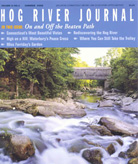(c) Connecticut Explored Inc. Summer 2008
Subscribe/Buy the Issue!
This wouldn’t be the first time I was a little “late to the party.” I admit I’d only been paying partial attention to the considerable effort by Senator Christopher Dodd, Senator Joseph Lieberman, and Congressman John Larson, along with a host of local cheerleaders, to get the National Park Service to adopt Coltsville in Hartford as a National Park. The Coltsville Historic District includes (much of it still intact) the 250 acres of lowland that Sam Colt acquired in the early 1850s and walled off from the annual spring flooding of the Connecticut River with two miles of dikes, the then-largest armory in the world that he built, along with worker’s housing, a wharf, worker amenities including a reading room and library, a school, a park, a theater, and the Colts’ Italianate mansion, Armsmear. After Sam’s death in 1862 and the destruction by fire of the armory during the Civil War, Elizabeth Colt rebuilt the business. The former gardens and grounds of Armsmear have been a public park since Elizabeth bequeathed them to the city in 1905. In 2003, President George W. Bush signed a bill authorizing the National Park Service to undertake a study. The effort was derailed, and then put back on track. Last December, the Coltsville Historic District was awarded the highest level of federal recognition as a National Historic Landmark, advancing the prospect of its becoming a National Park. That’s when I decided to take another look.
Maybe it was the gun-making and Sam Colt-hero-worship seemingly at the core of the Colt story that had kept me from fully engaging; maybe it was the “disconnect” between my idea of a National Park—the Grand Canyon or Yosemite—and the proposed site, a formerly industrial section of Hartford undergoing revitalization. More consistent with my idea of a National Park site was Connecticut’s only National Historic Site, Weir Farm, home of the American Impressionist artist J. Alden Weir, which incorporates some of the landscape he was so famous for capturing on canvas [see Destination, page 46].
I decided to take a look at “the competition.” How many National Parks did our neighbor Massachusetts have? I knew of and had visited the National Park at Lowell, Massachusetts, the famous mill town that tells the story of America’s industrial revolution. A look at the National Park Service’s Web site (www.nps.org) revealed that Massachusetts has a total of 17 National parks, historic sites, heritage corridors, and scenic trails. Connecticut has three: one site, one corridor, and one trail. We may be a small state, but based on the significance of Connecticut’s history, we’re worthy of more than three sites! (For your information, Rhode Island has three, Vermont has two, and New Hampshire has two—and we share one of these, the Appalachian Trail, with Vermont and New Hampshire).
Being adopted by the National Park Service would, according to Colt expert Bill Hosley, “bring together half a dozen stakeholders, each contributing their piece of the story, with the whole tied together and promoted by the National Park Service.” This would be similar, he adds, to historic parks in New Bedford, Salem, and Boston, where the Park Service owns and operates orientation centers that tie together independent attractions. In Hartford, those would include the Colt collections of guns, art, and decorative arts at the Wadsworth Atheneum and the Museum of Connecticut History, the Church of the Good Shepherd and other historic structures such as worker housing still extant in the neighborhood, and Colt Park and a new botanical garden that is in the organizing phase. [For more from Hosley on this story, see “Making a Success of Coltsville,” Winter 2005/2006/.]
So count me now as officially on the Coltsville National Park bandwagon. And a sincere thank you to our legislative and community leaders who have been carrying this ball tirelessly. As Governor M. Jodi Rell noted at an event in late January to celebrate the National Historic Landmark designation, it may feel at times like scaling a mountain, but the summit is in sight. Let’s keep our eye on the prize—and get to work identifying other potential National Historic Sites in our state!
Explore!
“Making a Success of Coltsville,” Winter 2005/2006
“The Suspicious Colt Armory Fire,” Fall 2006
“Sam Colt Mines the Arizona Territory,” Winter 2016-2017
“Connecticut’s Forest and Park Pioneers,” Winter 2016-2017

